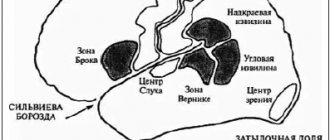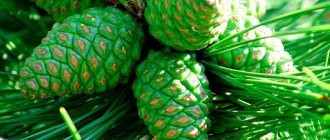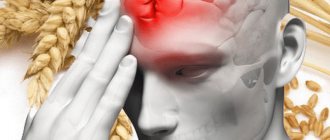General description of the disease
Stroke is a disease characterized by impaired blood circulation in the brain, leading to damage to brain tissue and disruption of its functions.
Types of stroke:
- Hemorrhagic.
- Ischemic.
Causes of stroke:
The main cause of stroke is impaired blood flow to areas of the brain as a result of damage or blockage of a cerebral artery. This can happen in the following cases:
- 1 detachment of a blood clot from the site of formation and its entry into the artery; brain, (embolism);
- 2 thrombus formation in the vessels of the brain (thrombosis). Usually occurs with atherosclerosis;
- 3 arterial hypertension;
- 4 arteries have congenital weak walls, for example, with an aneurysm;
- 5 injury as a result of an accident, a blow to the head, etc.
Symptoms of a stroke
- unexpected weakness, numbness or paralysis of the muscles of the arms, legs or face, usually on one side of the body;
- speech impairment, difficulties with correct pronunciation of words;
- sudden loss of vision in one or both eyes;
- loss of coordination of movement, up to loss of balance, severe unexpected dizziness;
- severe headaches of unknown nature and origin;
- an ischemic attack is the same as a micro-stroke, with similar symptoms and a duration of several seconds.
Herring reduces the risk of stroke
Stockholm scientists at the Karolinska Institute have found that eating fish two to three times a week as a food product significantly reduces the risk of stroke and cerebrovascular accidents.
According to the authors of this work, such effects of fish products are possible due to their high content of omega-3 fatty acids. These compounds have a beneficial effect on lipid metabolism by reducing the percentage of blood cholesterol, which underlies vascular damage and arterial hypertension. This conclusion was reached on the basis of 15 major studies that were carried out simultaneously in several countries around the world (Europe, China, Japan, USA).
The study involved about 400,000 people of different age categories (from 30 to 100 years), and the experiment itself lasted for 30 years! The result of the experiment was conclusions about the effect of fish on the general level of health. The results of the study showed the occurrence of stroke in only 9,400 people, which is significantly lower than global statistics.
There is an objective explanation for all these findings. The thing is that fish contains extremely important beneficial compounds. One of them is omega-3 fatty acids. They are the ones who protect the brain from stroke. Every person can experience their benefits if they eat fish at least twice a week. So says Dr. Dariush Mozaffarian, an associate professor at one of the departments at Harvard Medical University. According to many scientists, fish dishes are also a powerful source of selenium and vitamin D, which are important microelements for patients with heart and vascular diseases.
Dariush Mozaffarian found that fatty fish contain the most omega-3 lipids. These include salmon and herring. Grilled tuna has also been shown to have a positive effect on maintaining a normal heart rate.
These data are confirmed by scientists from the American Heart Association. They are also convinced that to prevent stroke conditions it is enough to cook and eat fish dishes at least twice a week. For people living in LIC countries, the most accessible fish product is herring, which can be emphasized as a source of omega-3 fatty acids for the body.
Other heart-healthy eating habits
Japan has a traditionally low incidence of cardiovascular disease and high life expectancy, especially on the island of Okinawa. It is there that the residents' diet consists of seaweed, fish and seafood, and the amount of rice consumed is less than in other regions of the island state.
Hong Kong is another area that is not affected by cardiovascular disease, although the death rate from heart disease is quite high in nearby China. Describing the “Hong Kong phenomenon ,” scientists associate it with the Cantonese diet, widespread throughout the province, which is followed by more than 50% of the population. It is based on lean meats, dietary poultry, a wide variety of seafood, and they try to cook dishes using steam.
Low incidence of cardiovascular diseases is recorded in ocean-bound Australia and New Zealand, where people mainly live on the coast and seafood is also widely available on the table. Traditional dishes also include low-fat and dietary crocodile meat and kangaroo meat.
Vitamin E saves the brain after a stroke
In high doses, vitamin E can prevent the death of nerve cells in the acute period of stroke. Long-term use of small doses prevents the development of this disease.
Such conclusions were made by scientists at the University of Ohio (USA), according to The Times of India magazine.
According to the explanations of the authors of this study, the most common signs of stroke are numbness and weakness of the limbs, which are unilateral in nature, impaired coordination of movements, sudden pallor of the skin, speech disorders, nausea accompanied by dizziness, impaired swallowing, visual and oculomotor disorders. In this case, the stroke itself develops in just a few minutes or even seconds, being the result of impaired blood flow to the brain. It can be either primarily acute in nature or formed against the background of previous transient attacks of cerebral circulatory disorders.
Many scientists classify vitamin E as a means that reliably reduces the severity of the consequences of stroke brain damage. Vitamin E can reduce the risk of stroke and its complications due to the ability to block the release of enzymes responsible for the accumulation of toxic lipids and their peroxidation products in nerve cells.
In an experiment on mice, it was possible to show that those neurons that received vitamin E for a long time contain 60% less oxidized fatty acids than those of control group mice that were not exposed to tocopherol.
Vitamin E exists in nature in several forms. The most common is alpha-tocotrienol.
Sources of Vitamin E
A natural source of this substance is sea fish, any vegetable oils, soy-based products, milk, herbs, eggs, meat, and liver. It is especially worth noting the benefits of alpha-tocotrienol palm oil, which is 70% represented by this substance. According to the standards of domestic medicine and many world countries, the daily requirement for vitamin E is about 10 mg.
Coffee
A cup of aromatic and invigorating drink is a great way to start the day. Coffee is considered a natural stimulant, so drinking it in small quantities will help reduce the risks associated with the onset of an ischemic attack. To prevent it, you need 2-4 cups of a weak drink daily. Caffeine-containing products are no less beneficial for stroke than pure coffee.
Chocolate protects against stroke
Scientists at the Karolinska Institutet in Stockholm conducted an interesting study, which found that chocolate significantly reduces the risk of stroke, especially in females of all age categories. About 30 thousand Swedish residents were involved in the research, which was published on the pages of Reuters.
The first scientific developments on this topic appeared back in 1997. Then a group of scientists led by Suzanne Larsson began observing the patients and recording data about them without taking into account the incidence of cardiac and vascular pathology. The age of the study participants ranged from 48 years to 84. They regularly underwent a number of examinations, and also regularly consumed a certain amount of chocolate. After 10 years, 1,549 cases of stroke were reported. At the same time, a consistent pattern was noted: the more chocolate consumed, the fewer women were susceptible to developing a stroke.
It has been established that the daily portion of chocolate should be 45 grams.
After studying these data, researchers at the University of California set out to substantiate the observed effects of chocolate in preventing brain damage from stroke. It was found that this effect is possible due to the high content of flavonoids in chocolate. Larrson herself reported that these substances help normalize blood pressure and strengthen the blood vessels of the brain and heart plexuses. To date, several large studies have been planned that would provide even more information about this phenomenon and the ability of chocolate to influence the course of stroke.
According to Suzanne Larrson: “It is too early to say with certainty that chocolate reduces the risk of stroke. Its benefits for the body have long been beyond doubt, but it should not be abused, since its calorie content is quite high. The content of sugars, fats and their various compounds is also high. Preference should be given to regular dark chocolate, which contains much less sugar and cocoa than milk chocolate.”
.
For people who are at risk for developing a stroke, doctors recommend that they categorically stop smoking, not be exposed to physical activity, and strictly follow a dietary regimen. It is worth noting that chocolate is not listed on any list of drugs that inhibit the development of stroke damage.
Larrson has proven that drinking two cups of coffee a day significantly reduces the risk of stroke among women by 20-24%. The results of all studies were published in the Journal of the American College of Cardiology.
Green tea
A lack of fluid in the body thickens the blood and provokes the formation of blood clots, and green tea prepared with distilled water helps to thin it, which reduces the chances of developing a stroke. The drink reduces the destructive effects of free radicals. Green tea is filled with unique antioxidants that help the brain stay functional for a long time.
Add to the collection of “delicious” recipes
Do not think that the above dietary restrictions will ruin your entire future life. The list of permitted products is large enough to be able to prepare tasty and healthy dishes from it. Here are some recipes.
Carrot and radish salad
Wash 2 small radishes and 2 carrots thoroughly, peel and grate on a fine grater. Then add 2 apples, peeled and grated. Mix everything. Add garlic crushed with fresh lemon zest (3-4 cloves), pour in lemon juice (you will need 1 lemon). Stir again, add salt, place in a salad bowl, and garnish with lemon slices.
Caesar salad"
This light and tasty salad is popular all over the world, and it is easy and simple to prepare. First you need to make garlic croutons: cut white bread (without crust) into cubes, sprinkle with vegetable oil infused with garlic (to do this, put crushed garlic in the oil for 15 minutes, then remove the garlic), bake in the oven until golden brown, cool. Rub the bottom and sides of a large salad bowl with another clove of garlic, put hand-torn lettuce leaves mixed with grated Parmesan cheese in it, cover with something and set aside. Then start preparing the dressing: place 1-2 eggs in boiling water and cook for exactly 1 minute, then break the eggs into a bowl (the whites should turn white, but the yolks should remain raw). Beat eggs together with 2 tablespoons. spoons of olive oil, 2 teaspoons. spoons of mustard (preferably French), 2 tablespoons. spoons of fresh lemon juice. Just before serving, add the dressing to the salad, stir and sprinkle with croutons on top. Alternatively, you can add pieces of boiled chicken breast or shrimp to the salad.
Turkey breasts in sweet and sour sauce
Boil turkey or chicken breast fillet and cut into pieces. Prepare a sauce from flour, sour cream (low-fat) and vegetable broth. Pour a little water into the pan, add the meat there, add chopped apples, soaked prunes and raisins on top, cover with a lid and simmer for 5 minutes, then pour in the sauce and simmer for another 10 minutes. Before serving, sprinkle with chopped herbs. To prepare the sauce, mix a tablespoon of flour with sour cream and pour this mixture into a boiling vegetable broth (75 g); let simmer for 5 minutes and strain.
Beef with plums
Cut the beef into portions, add salt and pepper and place in a saucepan. Place plums cut into slices on top of the meat (you can sprinkle them with sugar on the inside). Add water, close the lid and simmer in the oven for 2–2.5 hours. When serving, place the finished meat on a dish along with the plums and the resulting sauce, sprinkle with herbs on top.
White fish with lemon sauce
Mix vegetable oil and lemon juice, add salt, pepper and dry tarragon. Place the fish (pike perch, flounder, sole) on a baking sheet lined with foil, brush the top with the resulting dressing and place the fish in the oven for 10 minutes. Prepare the sauce by mixing lemon juice and lemon zest (optional), mayonnaise, mustard, herbs to taste. When serving the fish, spoon a little sauce on top of each serving.
Millet porridge with fruits and honey
Pour well-washed millet (50 g) into boiling milk (100 g), add sugar and cook until thickened; then add the washed prunes, dried apricots, raisins, stir, close the lid tightly and put in a low-heat oven for an hour. Serve with honey.
Roasted Brussels Sprouts
Boil the cabbage in salted water, drain in a colander (the smaller the cabbage, the tastier it is; large heads of cabbage develop a specific spicy taste). Then place it in a single layer on the frying pan. Grate the cheese and mix with sour cream (if desired, you can replace part of the cheese with feta cheese, and part of the sour cream with mayonnaise). Place the resulting thick mass on top of the cabbage and smooth it out. Sprinkle with breadcrumbs and place in the oven for 10–15 minutes (temperature 220 degrees). Serve hot.
Gnecki with tomatoes or salmon
Boil the potatoes in their jackets until almost done, cool slightly, remove the skins and grate (or mash) on a fine grater. Add flour to the potatoes (there should be about the same amount as mashed potatoes). Quickly knead the dough, roll it out into a sausage with a diameter of 2–3 cm, and cut into pieces. Boil water in a saucepan, add salt, add a few drops of vegetable oil, and place the nyekia in it. When they float to the surface, drain them in a colander. For the sauce: scald the tomatoes and remove the skins. Finely chop the onion and garlic, simmer in olive oil along with chopped tomatoes for 20-30 minutes. Salt, pepper, add a few tablespoons of olive oil. Pour the boiled gnecki with sauce, sprinkle with grated cheese, and garnish with green basil leaves.
Eggplant cake
Cut the eggplants lengthwise into slices, add salt and leave for half an hour, then rinse and dry. Fry on both sides in vegetable oil. Grind onions, herbs (dill, parsley) and sweet pepper. Cut the tomatoes into slices. Place a layer of hot eggplants in a deep dish, sprinkle them with onions, then peppers, then place the tomatoes and sprinkle with herbs. The next layer (across the previous one) is again hot eggplants, onions, peppers, tomatoes and herbs. There should be several such layers. When the dish has cooled, you can put it in the refrigerator to let it steep.
Bukhara pilaf with raisins
Sort a glass of rice, rinse and soak for 1.5–2 hours. Heat 3-4 tablespoons in a thick-bottomed container. spoons of vegetable oil, add carrots cut into strips and onions cut into rings. Fry for 10 minutes, then pour about a glass of boiling water, add washed, seeded raisins (3 tablespoons) and let simmer for 5-7 minutes. Add rice to the vegetables with raisins, pour in enough water to cover the rice by 1 cm. Close the dish and simmer over low heat for about 30 minutes. Mix the finished pilaf and place it in a heap on a dish.
Prunes stuffed with cottage cheese and nuts
Soak the prunes in cold boiled water and remove the seeds. Rub the cottage cheese through a sieve, mix with semolina, yolk, sugar and finely chopped toasted nuts. Stuff prunes with this mixture, place in a greased frying pan, add a little water and bake in the oven.
Viburnum jelly
Pour viburnum berries into a saucepan or clay pot, add a small amount of water and steam in the oven for 2-3 hours. After this, wipe the viburnum, dilute the resulting mass with hot water, add sugar and, bringing to a boil, brew the jelly, pouring in the diluted starch with constant stirring.
Other bee products
To recover from a stroke, not only honey is used, but also other bee products - pollen, bee bread, and bee venom. These components are suitable for both internal and external use, for example, in creams.
Bee venom improves blood and lymph circulation. The natural substance contains enzymes and other compounds that are similar to human nerve tissue. After a stroke, the product is used as part of a massage cream.
The healing cream has the following effects:
- improves the conductivity of nerve impulses;
- relieves swelling in the affected limbs;
- improves blood circulation in the arms and legs.
Be sure to consult your doctor about the use of bee venom; contraindications to the use of the component are heart failure, liver and kidney diseases.
For medicinal purposes, pollen rich in vitamin P is used. Vitamin P promotes vasodilation and regulates the functions of the nervous and endocrine systems. For use after a stroke, pollen is mixed with honey in equal quantities, taken 1 teaspoon and dissolved in the mouth. After consuming the mixture, do not eat or drink for half an hour.
An effective remedy for speeding up the recovery process after a stroke is bee bread. Bee bread is used 1 gram, placed under the tongue up to four to five times a day.
Balanced low-calorie diet.
To stick to this diet permanently, you need to gradually reduce the number of calories in your diet. Doctors believe that it is enough for men at risk to consume 2,000 calories per day, and for women - 1,600 calories. However, it is not recommended to immediately switch to such a diet, especially if your daily diet was very high in calories and you are overweight. This diet is primarily aimed at reducing weight and cholesterol levels , and is recommended for overweight people. The basis of the diet consists of foods rich in fiber and magnesium. Follow these guidelines when following this diet.
Limit the consumption of all fats, butter, fatty meats, margarine. Reduce your consumption of pork, lamb and fatty beef, replacing them with chicken, turkey, and rabbit meat. For dairy drinks, it is recommended to consume low-fat milk, cheeses, egg whites, and low-fat kefir. The most useful fish in the diet against stroke are cod and flounder, pink salmon, salmon, chum salmon, herring, tuna and sardines. Fruits and vegetables are allowed in any quantity, but special attention should be paid to tomatoes and bananas. Limit your consumption of potatoes, canned vegetables and fruits. The diet should contain nuts, legumes and cereals, as well as a large amount of whole grain bread. As for desserts, low-calorie puddings and jellies, sherbet, and baby puree are allowed. For drinks, give preference to coffee, green tea, still mineral water, unsweetened fruit juices, and vegetable cocktails.
Published THIS IS INTERESTING! LIKED? SAVE TO YOUR PAGE BY CLICKING THE BUTTON
Probiotics
In order for nutrients to be fully absorbed, it is important to maintain the functioning of the digestive system. To do this, regularly consume probiotics - products with lacto- and bifidobacteria. Yogurt, some types of cottage cheese, sauerkraut, kefir are the best way to get live cultures for intestinal microflora.











